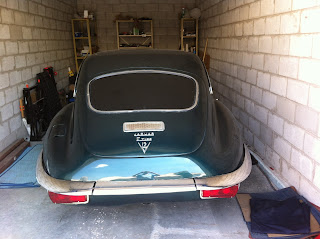An update, for the record, on a few things that have been going on with the car recently:
I read somewhere a couple of months ago that it is possible to get certificates of original factory records for Jaguar cars, so I contacted Jaguar Heritage Trust and was able to get the certificate for my car. It turns out that it was originally built in 1972, not 1973, as I had first thought - that was the registration year. Original distributor was British Leyland, Canada, and was originally dispatched from the factory in January 1973. The certificate has the numbers for the chassis, engine, body and gearbox, so, as I get further into the car, I can verify that each of these components is original. Good information to have, and a nice looking certificate to contain it!
I think I mentioned in an earlier post that I had bought new barrels for the door locks. I had the drivers side handle and lock off and disassembled, but couldn't put it back together with the new barrel so that it would work.
 |
| Door lock assembly that fits into the handle. It's the small plunger sticking out of the left-hand part that I can't get to seat correctly to lock the door. |
The other thing that's been on my mind with the car recently is a problem I'm having with the gearbox (auto transmission). A month or so ago I was driving the car around the storage area where I keep it. With no warning, I lost the drive, with a noise (didn't sound catastrophic, but it was there), and the engine revs increased significantly (not as far as redline).
Trying different selector positions, I found that reverse still worked fine. For another few feet, I still had some drive in position 2 on the selector, but then that stopped aswell.
I got the car back into the garage in reverse, with no further issues.
Since then, because I still had motion in reverse, I've been slowly adding transmission fluid to the 'box, 1/2 pint at a time. So far I've added 2 pints (capacity is 16 pints).
When checking for any progress today, once the car was warmed up, I still have reverse but can only get a creep forward in drive. However, positions 1 & 2 on the selector both give me "normal" positive forward motion (position 2 had stopped originally!).
Reading through the fault diagnosis section of my repair manual, the only check that it suggests for no forward drive in D, other than those suggested for the other selector positions is to check the rear band adjustment. I can't find any detail about how to check this in the manual, so assume it's a transmission strip-down check.
Having got drive back in selector positions 1 & 2, I'm tempted to continue topping up the fluid, but I don't want to run the risk of over-filling the 'box, although it is vented through the dipstick/filler tube, so worst case I would only expect it to spit fluid back up through that.
I'll go back early next week, when the weather is a bit warmer again, maybe add another 1/2 pint of ATF and see if it revives Drive.
For a while now I've been planning on putting the E-type into a shop to get the sill(s) replaced and other work that I can't do, to get the car into road-worthy condition so that I can drive it around this summer. There are a couple of places I've been considering. One does mechanical work on classic cars, although focuses mainly on MGs. Another is widely known because of TV advertising, and they seem to have done a lot on all types of classics. I'd pretty much decided on going with this latter one, until yesterday evening when I was talking to a friend who had taken his classic Corvette there. He had nothing good to say about this place, having had trouble with payments for the work done, as well as the quality of the parts they used. So that put me off going there. So I checked out the Ontario Jag Owners Assoc website, and found another classic restorer, not too far from here (which I like, so I can visit regularly while they have the car). I called them and have set up to go to visit them some time next week to check out their premises as well as discuss the work and phasing I'd like to consider having them undertake. Glad I've found a potential "restorer" and maintenance place - hopefully we can make something work.






